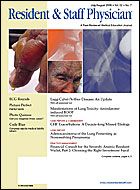Publication
Article
Resident & Staff Physician®
Managing Eye Diseases in the 21st Century
Author(s):
Tommy S. Korn, MD, FACS; Attending Ophthalmologist and Surgeon, Cornea and External Disease Service, Department of Ophthalmology, Sharp Memorial Hospital, and Assistant Clinical Professor of Ophthalmology, University of California, San Diego, School of Medicine, San Diego, Calif
"
The eye does not see what the mind does not know."
This was quoted to me when I first began my ophthalmology residency training in the twentieth century. The beginning of the twenty-first century has become a very exciting period in ophthalmology thanks to new diagnostic modalities and treatments that have been developed to treat eye diseases previously thought incurable. Providing this state-of-theart ophthalmic care for our patients, however, requires all physicians to become aware of eye disease and to visually recognize pathology when examining the eye. As a result of the expanding knowledge of medicine, many graduating physicians who do not pursue a career in ophthalmology become unnerved when asked to examine their patients' eyes or to address their visual complaints. Primary care physicians and residents often are the first to encounter eye or vision disturbances in patients. And although most eye conditions are benign, some may represent an early manifestation of an underlying systemic process that threatens not only eyesight but even life. Eyesight is a gift that both patients and physicians routinely take for granted, until it is threatened or gone. Physicians who gain knowledge about eye disease can improve their patients' overall health by making correct diagnoses, prescribing appropriate treatments, and giving timely referrals to eye care specialists.
In this special issue, leading ophthalmologists from across the country discuss recent advances in eye care and provide a comprehensive review of the most important eye diseases that you are likely to encounter in your practice. The red eye, for example, is the most common eye condition among adult and pediatric patients. Most red eye presentations are typically benign and self-limiting, but some cases may represent a harbinger of systemic disease or can cause blindness. With the aging of the baby boomer population, primary care physicians are also likely to encounter age-related macular degeneration and glaucoma. Macular degeneration is, by far, the leading cause of central blindness among the elderly and has been traditionally considered an irreversible cause of central vision blindness. Significant strides have been made in slowing the progression of this disease with recent innovations in lasers and therapeutic drugs. Any success, however, will require the aid of physicians who recognize the early signs and symptoms. In contrast, glaucoma initially causes loss of peripheral vision and is asymptomatic. It is the leading cause of blindness among blacks. Improved pharmacologic and surgical treatments have been developed, but these too require increased physician awareness that will result in earlier diagnosis and treatment.
Resident & Staff Physician
Many eye conditions can still be optimally managed in the primary care setting. Increased awareness and visual recognition of serious eye diseases by primary care physicians will also help expedite the referral of patients who require the assistance of ophthalmologists. We hope that you will save this special issue of as a reference to help you manage patients who present with eye disease.
